Business Report: Investment Appraisal, Funding & Procurement for K plc
VerifiedAdded on 2023/06/16
|15
|3826
|133
Report
AI Summary
This business report provides a comprehensive analysis of K plc's investment appraisal, funding options, cost variance, and procurement strategies. Task A evaluates several investment projects using payback period and net present value (NPV) methods, ranking them and recommending a project based on these analyses while also discussing the strengths and weaknesses of each method and qualitative factors for consideration. Task B suggests and discusses alternative funding methods for K plc's acquisition plans. Task C presents a full variance analysis of variable cost elements, offering possible explanations for the identified variances. Finally, Task D distinguishes between centralized and decentralized procurement, discussing the benefits of each approach. The report concludes with key findings and recommendations for K plc.
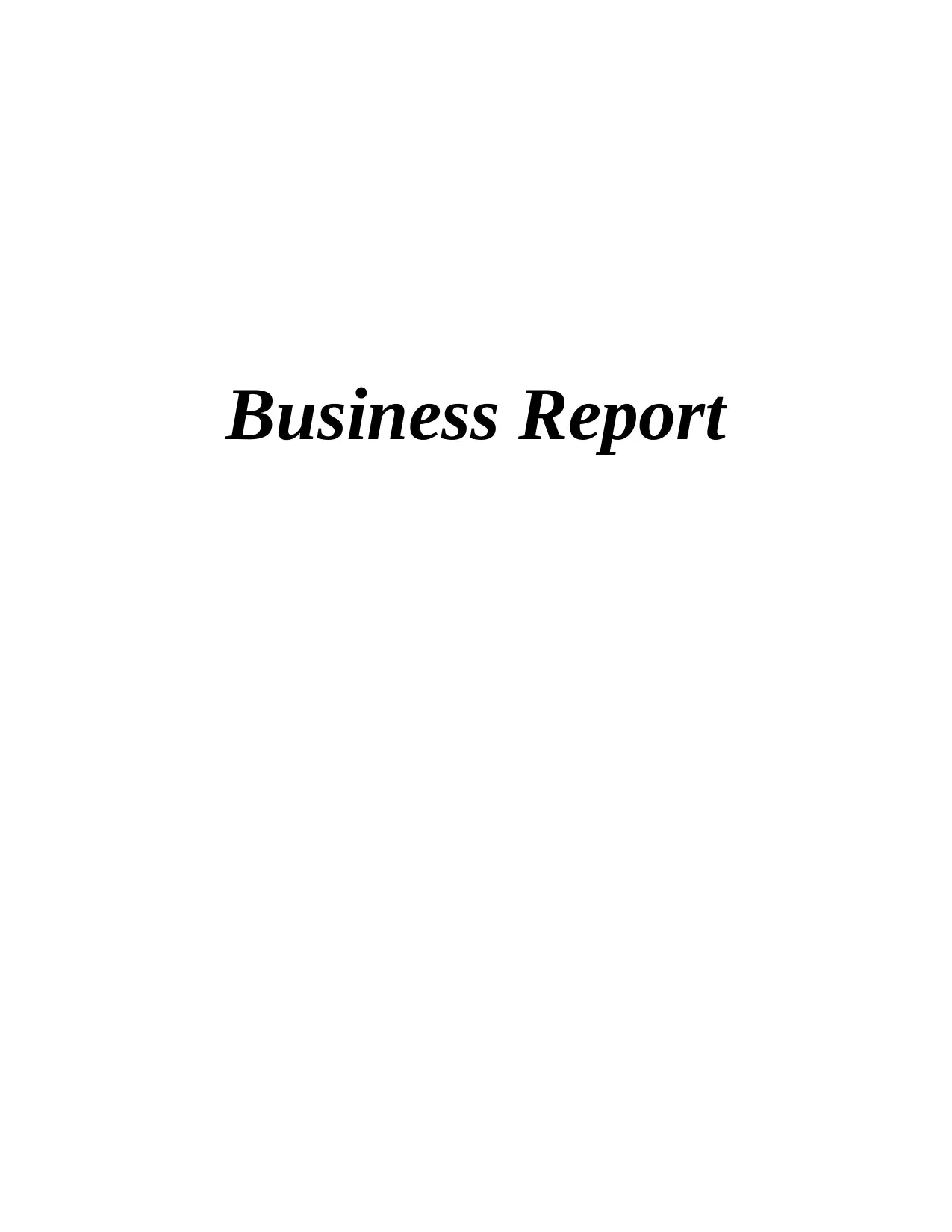
Business Report
Paraphrase This Document
Need a fresh take? Get an instant paraphrase of this document with our AI Paraphraser
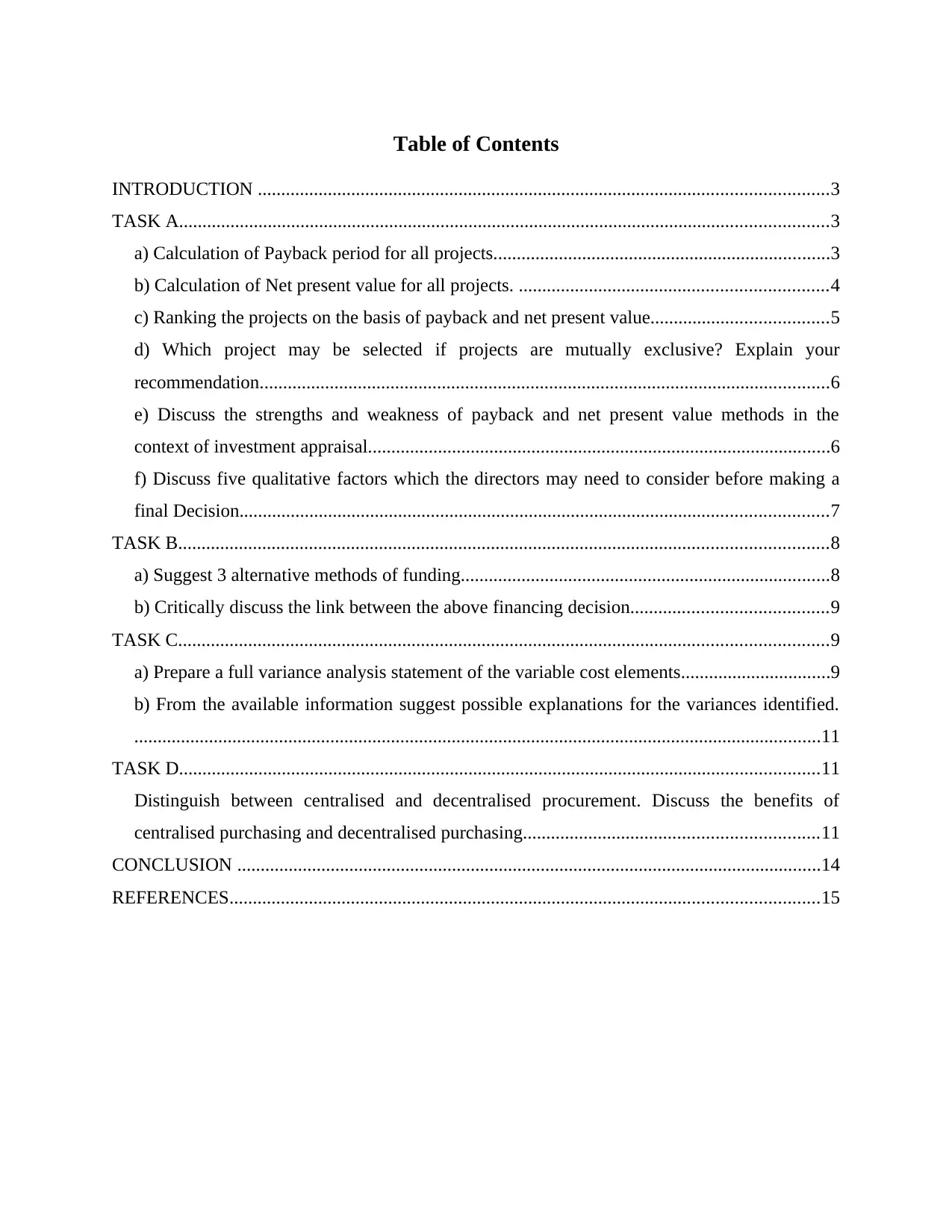
Table of Contents
INTRODUCTION ..........................................................................................................................3
TASK A...........................................................................................................................................3
a) Calculation of Payback period for all projects........................................................................3
b) Calculation of Net present value for all projects. ..................................................................4
c) Ranking the projects on the basis of payback and net present value......................................5
d) Which project may be selected if projects are mutually exclusive? Explain your
recommendation..........................................................................................................................6
e) Discuss the strengths and weakness of payback and net present value methods in the
context of investment appraisal...................................................................................................6
f) Discuss five qualitative factors which the directors may need to consider before making a
final Decision..............................................................................................................................7
TASK B...........................................................................................................................................8
a) Suggest 3 alternative methods of funding...............................................................................8
b) Critically discuss the link between the above financing decision..........................................9
TASK C...........................................................................................................................................9
a) Prepare a full variance analysis statement of the variable cost elements................................9
b) From the available information suggest possible explanations for the variances identified.
...................................................................................................................................................11
TASK D.........................................................................................................................................11
Distinguish between centralised and decentralised procurement. Discuss the benefits of
centralised purchasing and decentralised purchasing...............................................................11
CONCLUSION .............................................................................................................................14
REFERENCES..............................................................................................................................15
INTRODUCTION ..........................................................................................................................3
TASK A...........................................................................................................................................3
a) Calculation of Payback period for all projects........................................................................3
b) Calculation of Net present value for all projects. ..................................................................4
c) Ranking the projects on the basis of payback and net present value......................................5
d) Which project may be selected if projects are mutually exclusive? Explain your
recommendation..........................................................................................................................6
e) Discuss the strengths and weakness of payback and net present value methods in the
context of investment appraisal...................................................................................................6
f) Discuss five qualitative factors which the directors may need to consider before making a
final Decision..............................................................................................................................7
TASK B...........................................................................................................................................8
a) Suggest 3 alternative methods of funding...............................................................................8
b) Critically discuss the link between the above financing decision..........................................9
TASK C...........................................................................................................................................9
a) Prepare a full variance analysis statement of the variable cost elements................................9
b) From the available information suggest possible explanations for the variances identified.
...................................................................................................................................................11
TASK D.........................................................................................................................................11
Distinguish between centralised and decentralised procurement. Discuss the benefits of
centralised purchasing and decentralised purchasing...............................................................11
CONCLUSION .............................................................................................................................14
REFERENCES..............................................................................................................................15

INTRODUCTION
Business report refers to a series of information about a company's operations, production and
insights about what the company plans for future. This report contains mostly the historical data
about the company's working (Grefen and et. al., 2019). It helps the different users of this report
to critically analyse the options that they are available with to conclude a decision. It is taking
future decisions on the factual historical data present in the business report. In this report, the
main focus is on the different information which is accounting and operational of K plc. The
report is divided into four parts, part A researches the project which k plc. should invest in. part
B talks about the financing that the company can go with. Part C evaluates the company's cost
variances and Part D highlights the general overview of centralised and decentralised
procurement.
TASK A
a) Calculation of Payback period for all projects.
Payback period = Initial investment / Annual Cash flow
Table showing calculation of Payback period of Projects A-F
PROJECT Initial investment / Annual Cash flow Payback Period
A 1000000 / 300000 3.33 Years
B 400000 / 100000 4 Years
C 700000 / 200000 3.5 years
D 614500 / 100000 6.14 years
E 500000 / 120000 4.16 years
F 560000 / 100000 5.6 years
Project G (Using Cumulative cash flow)
YEAR ANNUAL CASH FLOW CUMULATIVE CASH FLOW
0 -200000 -200000
1 100000 -100000
Business report refers to a series of information about a company's operations, production and
insights about what the company plans for future. This report contains mostly the historical data
about the company's working (Grefen and et. al., 2019). It helps the different users of this report
to critically analyse the options that they are available with to conclude a decision. It is taking
future decisions on the factual historical data present in the business report. In this report, the
main focus is on the different information which is accounting and operational of K plc. The
report is divided into four parts, part A researches the project which k plc. should invest in. part
B talks about the financing that the company can go with. Part C evaluates the company's cost
variances and Part D highlights the general overview of centralised and decentralised
procurement.
TASK A
a) Calculation of Payback period for all projects.
Payback period = Initial investment / Annual Cash flow
Table showing calculation of Payback period of Projects A-F
PROJECT Initial investment / Annual Cash flow Payback Period
A 1000000 / 300000 3.33 Years
B 400000 / 100000 4 Years
C 700000 / 200000 3.5 years
D 614500 / 100000 6.14 years
E 500000 / 120000 4.16 years
F 560000 / 100000 5.6 years
Project G (Using Cumulative cash flow)
YEAR ANNUAL CASH FLOW CUMULATIVE CASH FLOW
0 -200000 -200000
1 100000 -100000
⊘ This is a preview!⊘
Do you want full access?
Subscribe today to unlock all pages.

Trusted by 1+ million students worldwide
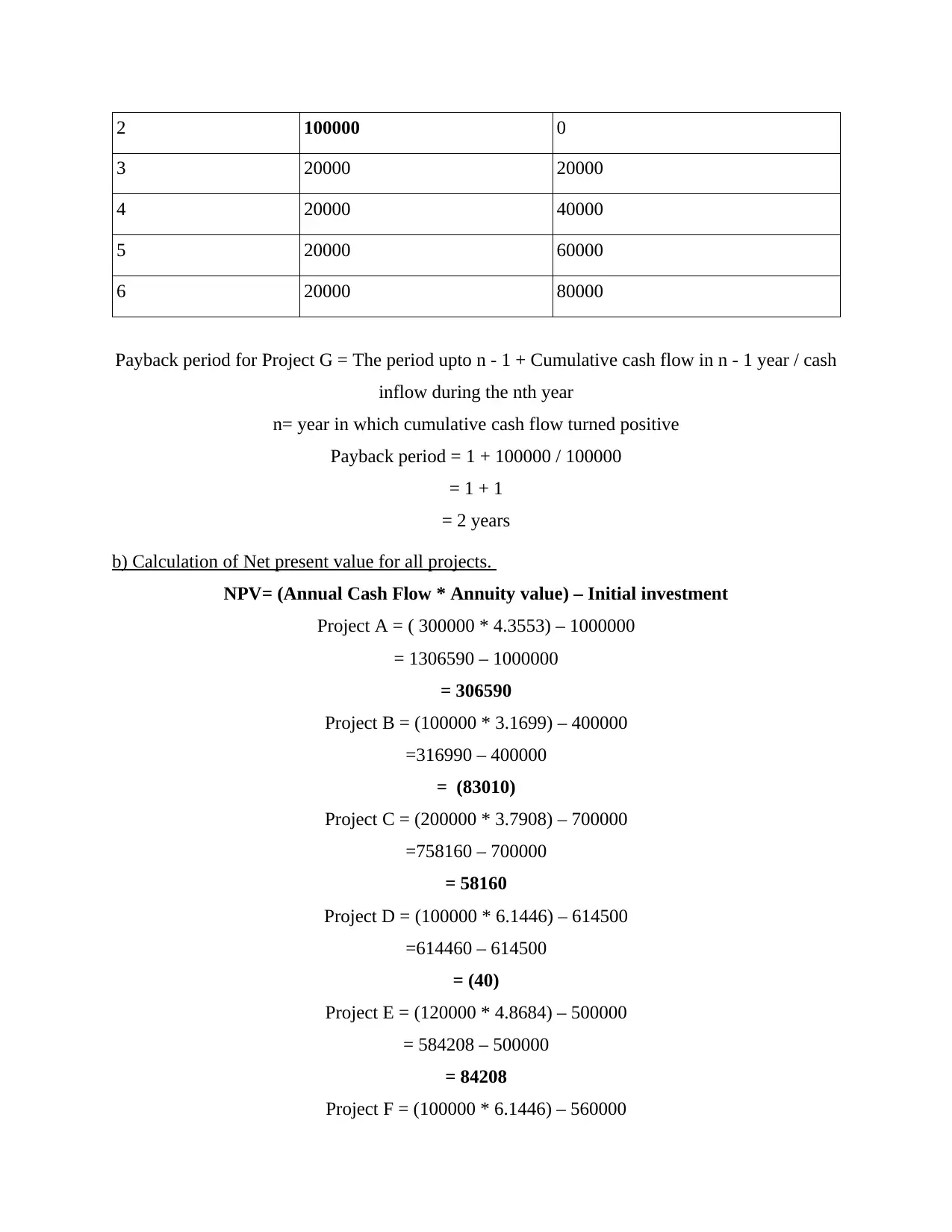
2 100000 0
3 20000 20000
4 20000 40000
5 20000 60000
6 20000 80000
Payback period for Project G = The period upto n - 1 + Cumulative cash flow in n - 1 year / cash
inflow during the nth year
n= year in which cumulative cash flow turned positive
Payback period = 1 + 100000 / 100000
= 1 + 1
= 2 years
b) Calculation of Net present value for all projects.
NPV= (Annual Cash Flow * Annuity value) – Initial investment
Project A = ( 300000 * 4.3553) – 1000000
= 1306590 – 1000000
= 306590
Project B = (100000 * 3.1699) – 400000
=316990 – 400000
= (83010)
Project C = (200000 * 3.7908) – 700000
=758160 – 700000
= 58160
Project D = (100000 * 6.1446) – 614500
=614460 – 614500
= (40)
Project E = (120000 * 4.8684) – 500000
= 584208 – 500000
= 84208
Project F = (100000 * 6.1446) – 560000
3 20000 20000
4 20000 40000
5 20000 60000
6 20000 80000
Payback period for Project G = The period upto n - 1 + Cumulative cash flow in n - 1 year / cash
inflow during the nth year
n= year in which cumulative cash flow turned positive
Payback period = 1 + 100000 / 100000
= 1 + 1
= 2 years
b) Calculation of Net present value for all projects.
NPV= (Annual Cash Flow * Annuity value) – Initial investment
Project A = ( 300000 * 4.3553) – 1000000
= 1306590 – 1000000
= 306590
Project B = (100000 * 3.1699) – 400000
=316990 – 400000
= (83010)
Project C = (200000 * 3.7908) – 700000
=758160 – 700000
= 58160
Project D = (100000 * 6.1446) – 614500
=614460 – 614500
= (40)
Project E = (120000 * 4.8684) – 500000
= 584208 – 500000
= 84208
Project F = (100000 * 6.1446) – 560000
Paraphrase This Document
Need a fresh take? Get an instant paraphrase of this document with our AI Paraphraser
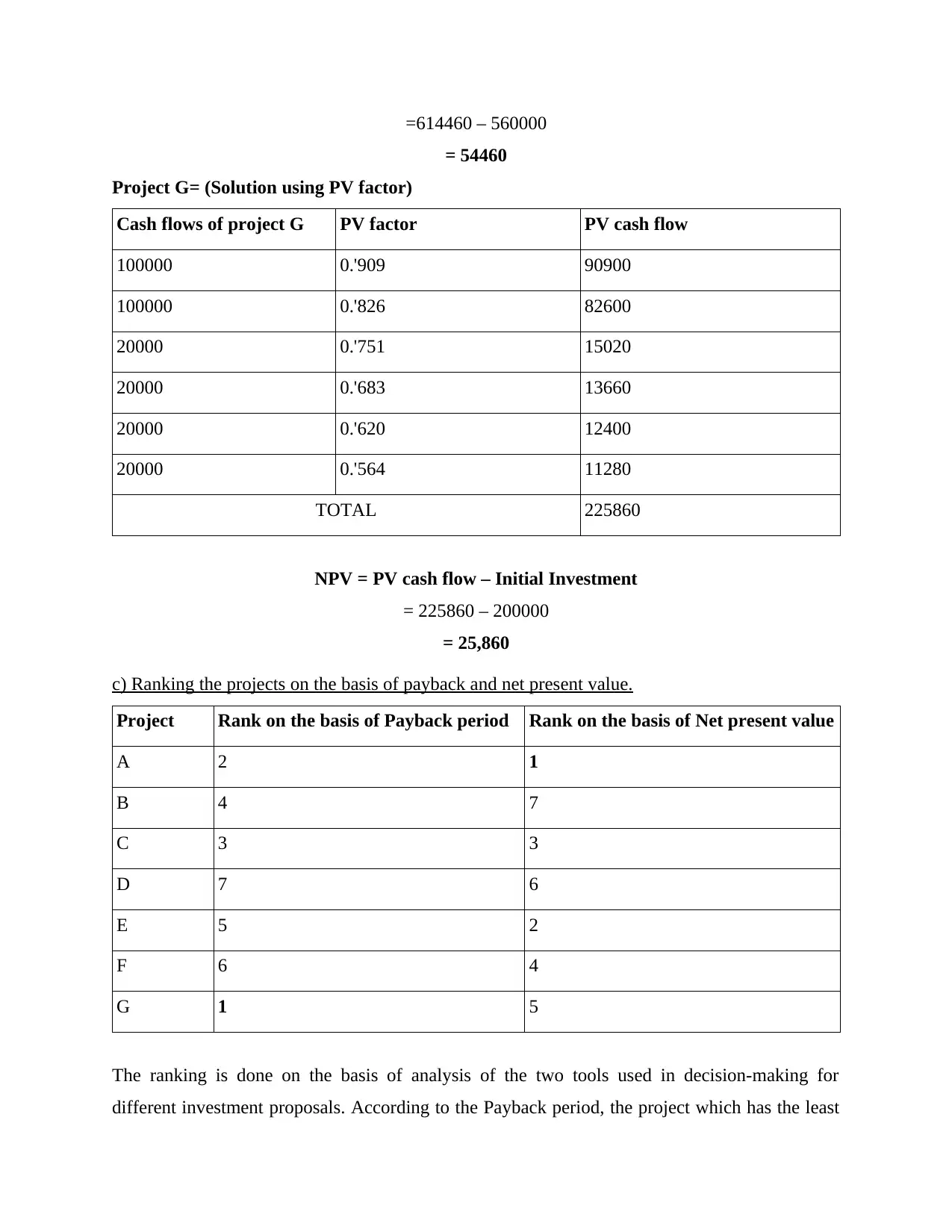
=614460 – 560000
= 54460
Project G= (Solution using PV factor)
Cash flows of project G PV factor PV cash flow
100000 0.'909 90900
100000 0.'826 82600
20000 0.'751 15020
20000 0.'683 13660
20000 0.'620 12400
20000 0.'564 11280
TOTAL 225860
NPV = PV cash flow – Initial Investment
= 225860 – 200000
= 25,860
c) Ranking the projects on the basis of payback and net present value.
Project Rank on the basis of Payback period Rank on the basis of Net present value
A 2 1
B 4 7
C 3 3
D 7 6
E 5 2
F 6 4
G 1 5
The ranking is done on the basis of analysis of the two tools used in decision-making for
different investment proposals. According to the Payback period, the project which has the least
= 54460
Project G= (Solution using PV factor)
Cash flows of project G PV factor PV cash flow
100000 0.'909 90900
100000 0.'826 82600
20000 0.'751 15020
20000 0.'683 13660
20000 0.'620 12400
20000 0.'564 11280
TOTAL 225860
NPV = PV cash flow – Initial Investment
= 225860 – 200000
= 25,860
c) Ranking the projects on the basis of payback and net present value.
Project Rank on the basis of Payback period Rank on the basis of Net present value
A 2 1
B 4 7
C 3 3
D 7 6
E 5 2
F 6 4
G 1 5
The ranking is done on the basis of analysis of the two tools used in decision-making for
different investment proposals. According to the Payback period, the project which has the least
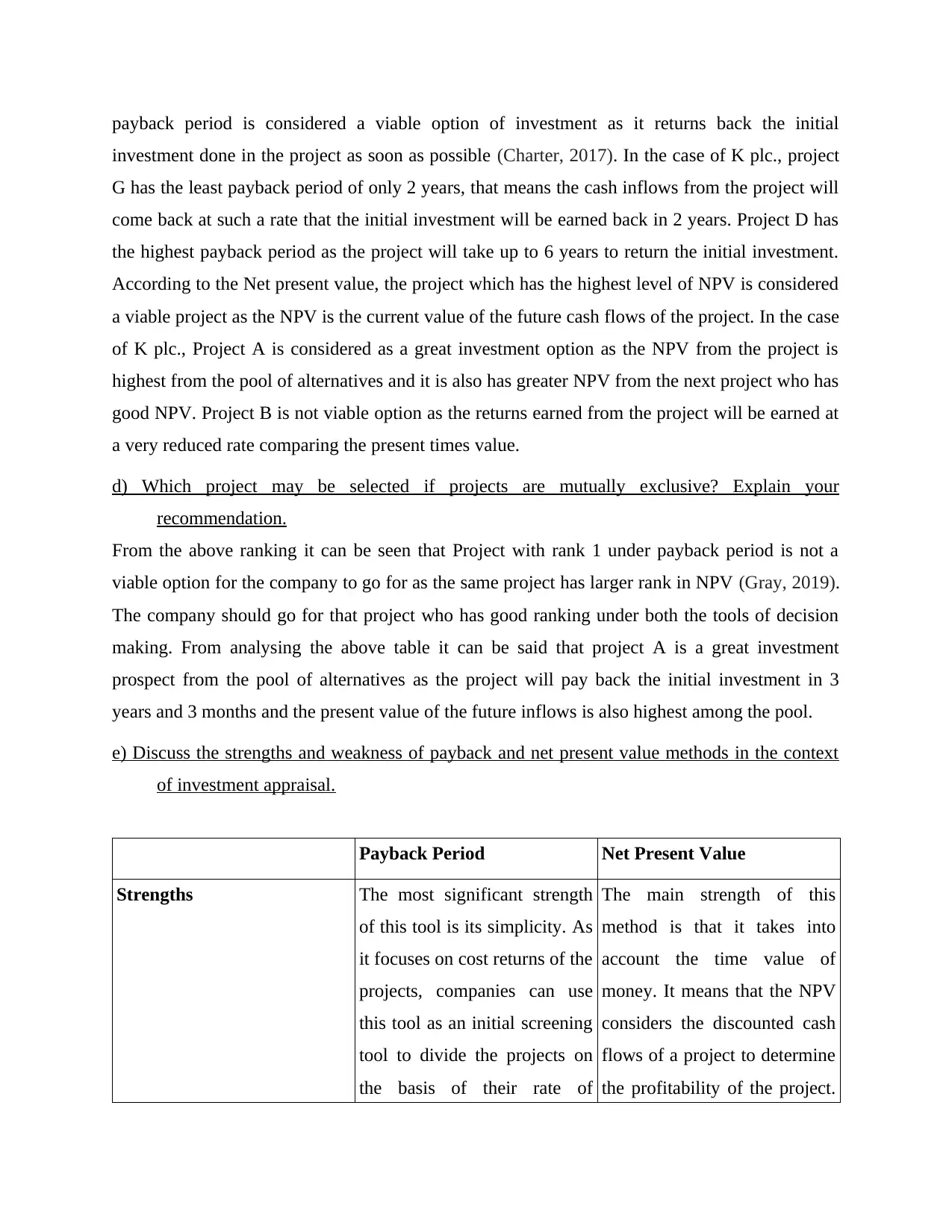
payback period is considered a viable option of investment as it returns back the initial
investment done in the project as soon as possible (Charter, 2017). In the case of K plc., project
G has the least payback period of only 2 years, that means the cash inflows from the project will
come back at such a rate that the initial investment will be earned back in 2 years. Project D has
the highest payback period as the project will take up to 6 years to return the initial investment.
According to the Net present value, the project which has the highest level of NPV is considered
a viable project as the NPV is the current value of the future cash flows of the project. In the case
of K plc., Project A is considered as a great investment option as the NPV from the project is
highest from the pool of alternatives and it is also has greater NPV from the next project who has
good NPV. Project B is not viable option as the returns earned from the project will be earned at
a very reduced rate comparing the present times value.
d) Which project may be selected if projects are mutually exclusive? Explain your
recommendation.
From the above ranking it can be seen that Project with rank 1 under payback period is not a
viable option for the company to go for as the same project has larger rank in NPV (Gray, 2019).
The company should go for that project who has good ranking under both the tools of decision
making. From analysing the above table it can be said that project A is a great investment
prospect from the pool of alternatives as the project will pay back the initial investment in 3
years and 3 months and the present value of the future inflows is also highest among the pool.
e) Discuss the strengths and weakness of payback and net present value methods in the context
of investment appraisal.
Payback Period Net Present Value
Strengths The most significant strength
of this tool is its simplicity. As
it focuses on cost returns of the
projects, companies can use
this tool as an initial screening
tool to divide the projects on
the basis of their rate of
The main strength of this
method is that it takes into
account the time value of
money. It means that the NPV
considers the discounted cash
flows of a project to determine
the profitability of the project.
investment done in the project as soon as possible (Charter, 2017). In the case of K plc., project
G has the least payback period of only 2 years, that means the cash inflows from the project will
come back at such a rate that the initial investment will be earned back in 2 years. Project D has
the highest payback period as the project will take up to 6 years to return the initial investment.
According to the Net present value, the project which has the highest level of NPV is considered
a viable project as the NPV is the current value of the future cash flows of the project. In the case
of K plc., Project A is considered as a great investment option as the NPV from the project is
highest from the pool of alternatives and it is also has greater NPV from the next project who has
good NPV. Project B is not viable option as the returns earned from the project will be earned at
a very reduced rate comparing the present times value.
d) Which project may be selected if projects are mutually exclusive? Explain your
recommendation.
From the above ranking it can be seen that Project with rank 1 under payback period is not a
viable option for the company to go for as the same project has larger rank in NPV (Gray, 2019).
The company should go for that project who has good ranking under both the tools of decision
making. From analysing the above table it can be said that project A is a great investment
prospect from the pool of alternatives as the project will pay back the initial investment in 3
years and 3 months and the present value of the future inflows is also highest among the pool.
e) Discuss the strengths and weakness of payback and net present value methods in the context
of investment appraisal.
Payback Period Net Present Value
Strengths The most significant strength
of this tool is its simplicity. As
it focuses on cost returns of the
projects, companies can use
this tool as an initial screening
tool to divide the projects on
the basis of their rate of
The main strength of this
method is that it takes into
account the time value of
money. It means that the NPV
considers the discounted cash
flows of a project to determine
the profitability of the project.
⊘ This is a preview!⊘
Do you want full access?
Subscribe today to unlock all pages.

Trusted by 1+ million students worldwide
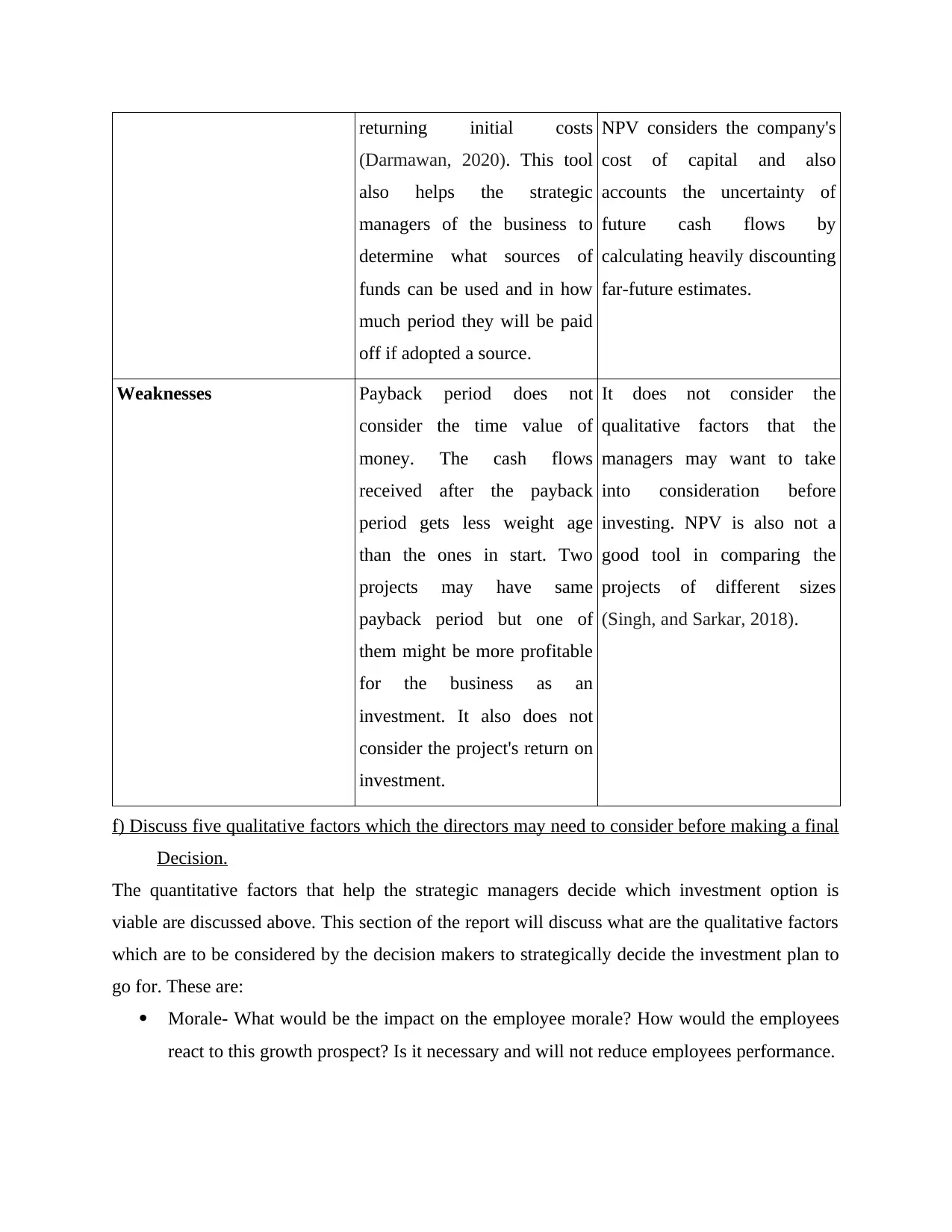
returning initial costs
(Darmawan, 2020). This tool
also helps the strategic
managers of the business to
determine what sources of
funds can be used and in how
much period they will be paid
off if adopted a source.
NPV considers the company's
cost of capital and also
accounts the uncertainty of
future cash flows by
calculating heavily discounting
far-future estimates.
Weaknesses Payback period does not
consider the time value of
money. The cash flows
received after the payback
period gets less weight age
than the ones in start. Two
projects may have same
payback period but one of
them might be more profitable
for the business as an
investment. It also does not
consider the project's return on
investment.
It does not consider the
qualitative factors that the
managers may want to take
into consideration before
investing. NPV is also not a
good tool in comparing the
projects of different sizes
(Singh, and Sarkar, 2018).
f) Discuss five qualitative factors which the directors may need to consider before making a final
Decision.
The quantitative factors that help the strategic managers decide which investment option is
viable are discussed above. This section of the report will discuss what are the qualitative factors
which are to be considered by the decision makers to strategically decide the investment plan to
go for. These are:
Morale- What would be the impact on the employee morale? How would the employees
react to this growth prospect? Is it necessary and will not reduce employees performance.
(Darmawan, 2020). This tool
also helps the strategic
managers of the business to
determine what sources of
funds can be used and in how
much period they will be paid
off if adopted a source.
NPV considers the company's
cost of capital and also
accounts the uncertainty of
future cash flows by
calculating heavily discounting
far-future estimates.
Weaknesses Payback period does not
consider the time value of
money. The cash flows
received after the payback
period gets less weight age
than the ones in start. Two
projects may have same
payback period but one of
them might be more profitable
for the business as an
investment. It also does not
consider the project's return on
investment.
It does not consider the
qualitative factors that the
managers may want to take
into consideration before
investing. NPV is also not a
good tool in comparing the
projects of different sizes
(Singh, and Sarkar, 2018).
f) Discuss five qualitative factors which the directors may need to consider before making a final
Decision.
The quantitative factors that help the strategic managers decide which investment option is
viable are discussed above. This section of the report will discuss what are the qualitative factors
which are to be considered by the decision makers to strategically decide the investment plan to
go for. These are:
Morale- What would be the impact on the employee morale? How would the employees
react to this growth prospect? Is it necessary and will not reduce employees performance.
Paraphrase This Document
Need a fresh take? Get an instant paraphrase of this document with our AI Paraphraser
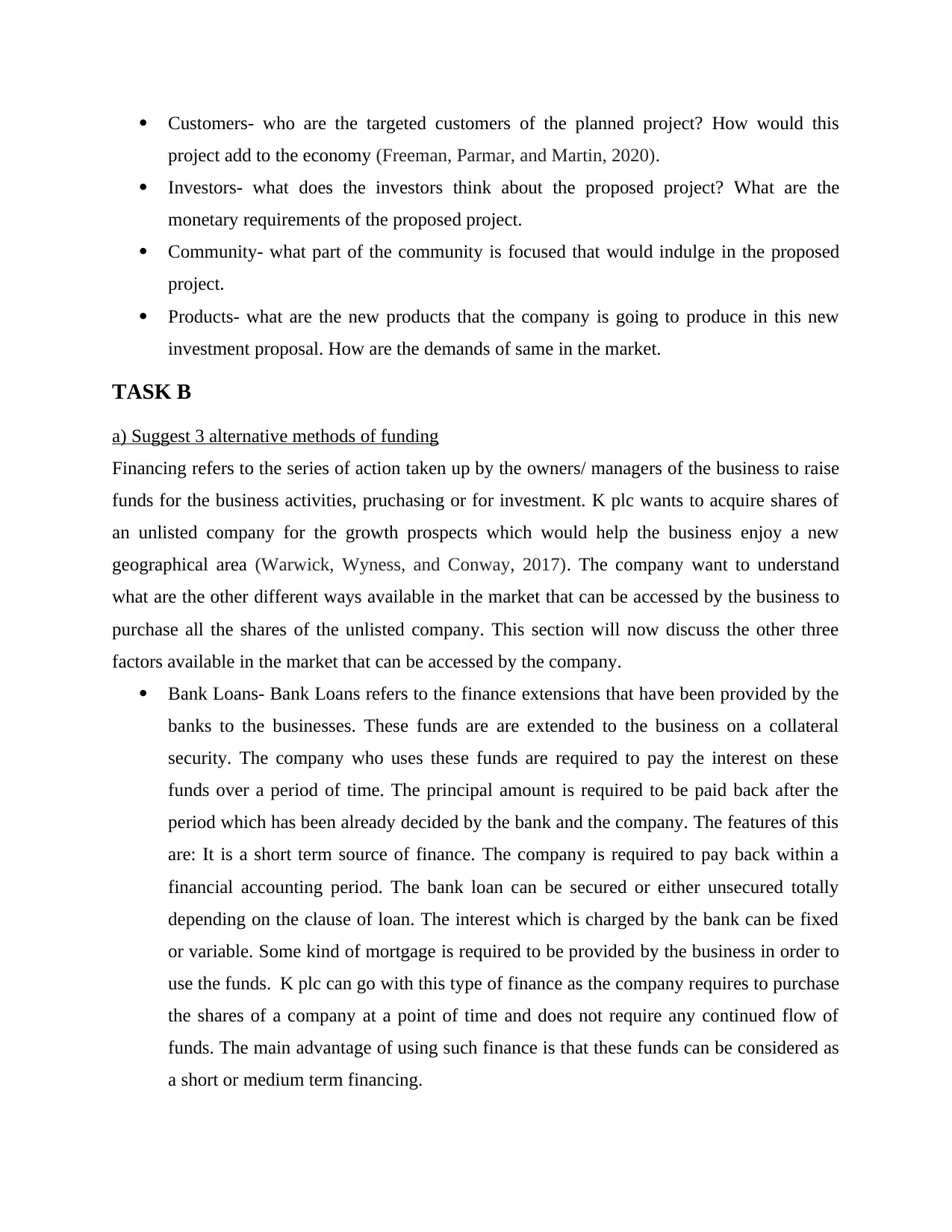
Customers- who are the targeted customers of the planned project? How would this
project add to the economy (Freeman, Parmar, and Martin, 2020).
Investors- what does the investors think about the proposed project? What are the
monetary requirements of the proposed project.
Community- what part of the community is focused that would indulge in the proposed
project.
Products- what are the new products that the company is going to produce in this new
investment proposal. How are the demands of same in the market.
TASK B
a) Suggest 3 alternative methods of funding
Financing refers to the series of action taken up by the owners/ managers of the business to raise
funds for the business activities, pruchasing or for investment. K plc wants to acquire shares of
an unlisted company for the growth prospects which would help the business enjoy a new
geographical area (Warwick, Wyness, and Conway, 2017). The company want to understand
what are the other different ways available in the market that can be accessed by the business to
purchase all the shares of the unlisted company. This section will now discuss the other three
factors available in the market that can be accessed by the company.
Bank Loans- Bank Loans refers to the finance extensions that have been provided by the
banks to the businesses. These funds are are extended to the business on a collateral
security. The company who uses these funds are required to pay the interest on these
funds over a period of time. The principal amount is required to be paid back after the
period which has been already decided by the bank and the company. The features of this
are: It is a short term source of finance. The company is required to pay back within a
financial accounting period. The bank loan can be secured or either unsecured totally
depending on the clause of loan. The interest which is charged by the bank can be fixed
or variable. Some kind of mortgage is required to be provided by the business in order to
use the funds. K plc can go with this type of finance as the company requires to purchase
the shares of a company at a point of time and does not require any continued flow of
funds. The main advantage of using such finance is that these funds can be considered as
a short or medium term financing.
project add to the economy (Freeman, Parmar, and Martin, 2020).
Investors- what does the investors think about the proposed project? What are the
monetary requirements of the proposed project.
Community- what part of the community is focused that would indulge in the proposed
project.
Products- what are the new products that the company is going to produce in this new
investment proposal. How are the demands of same in the market.
TASK B
a) Suggest 3 alternative methods of funding
Financing refers to the series of action taken up by the owners/ managers of the business to raise
funds for the business activities, pruchasing or for investment. K plc wants to acquire shares of
an unlisted company for the growth prospects which would help the business enjoy a new
geographical area (Warwick, Wyness, and Conway, 2017). The company want to understand
what are the other different ways available in the market that can be accessed by the business to
purchase all the shares of the unlisted company. This section will now discuss the other three
factors available in the market that can be accessed by the company.
Bank Loans- Bank Loans refers to the finance extensions that have been provided by the
banks to the businesses. These funds are are extended to the business on a collateral
security. The company who uses these funds are required to pay the interest on these
funds over a period of time. The principal amount is required to be paid back after the
period which has been already decided by the bank and the company. The features of this
are: It is a short term source of finance. The company is required to pay back within a
financial accounting period. The bank loan can be secured or either unsecured totally
depending on the clause of loan. The interest which is charged by the bank can be fixed
or variable. Some kind of mortgage is required to be provided by the business in order to
use the funds. K plc can go with this type of finance as the company requires to purchase
the shares of a company at a point of time and does not require any continued flow of
funds. The main advantage of using such finance is that these funds can be considered as
a short or medium term financing.
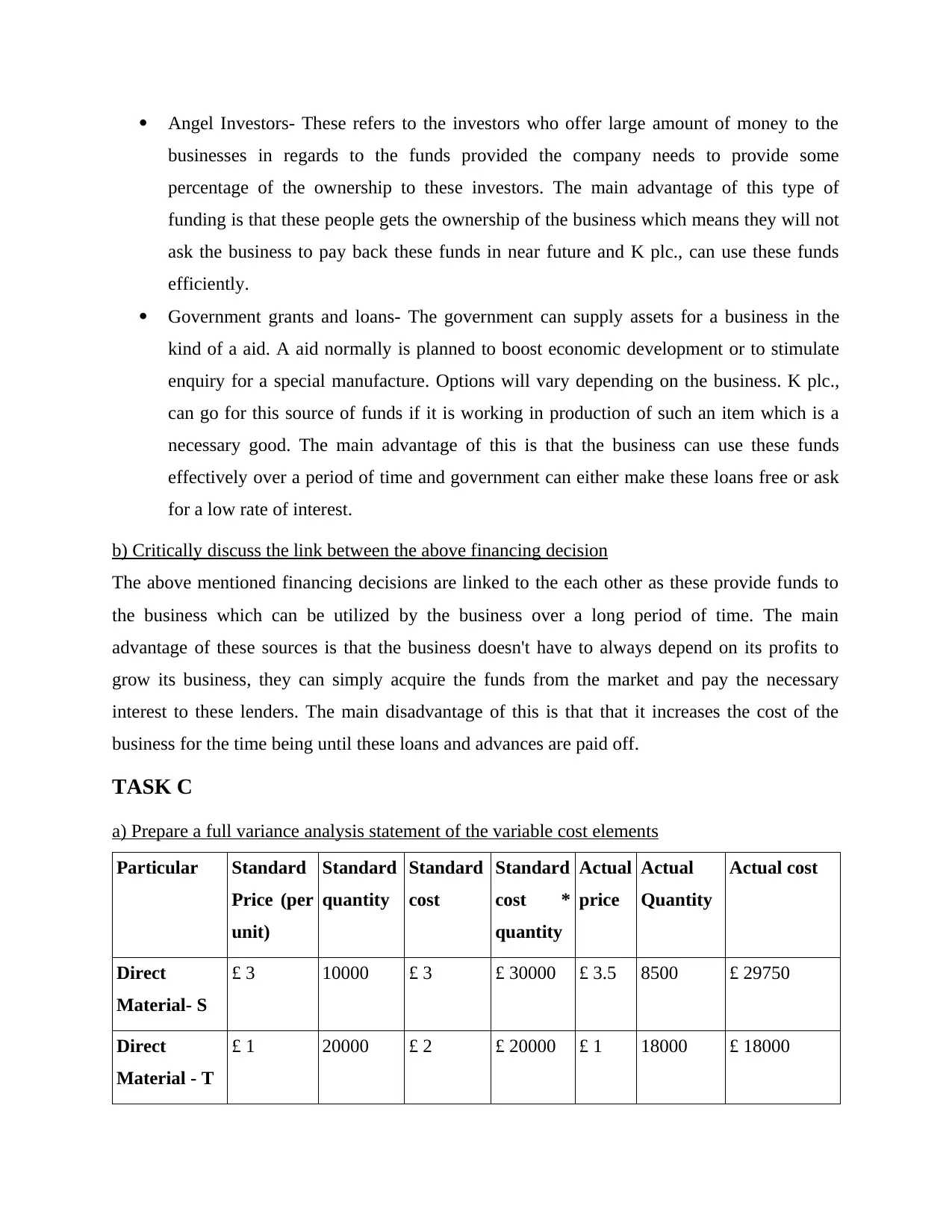
Angel Investors- These refers to the investors who offer large amount of money to the
businesses in regards to the funds provided the company needs to provide some
percentage of the ownership to these investors. The main advantage of this type of
funding is that these people gets the ownership of the business which means they will not
ask the business to pay back these funds in near future and K plc., can use these funds
efficiently.
Government grants and loans- The government can supply assets for a business in the
kind of a aid. A aid normally is planned to boost economic development or to stimulate
enquiry for a special manufacture. Options will vary depending on the business. K plc.,
can go for this source of funds if it is working in production of such an item which is a
necessary good. The main advantage of this is that the business can use these funds
effectively over a period of time and government can either make these loans free or ask
for a low rate of interest.
b) Critically discuss the link between the above financing decision
The above mentioned financing decisions are linked to the each other as these provide funds to
the business which can be utilized by the business over a long period of time. The main
advantage of these sources is that the business doesn't have to always depend on its profits to
grow its business, they can simply acquire the funds from the market and pay the necessary
interest to these lenders. The main disadvantage of this is that that it increases the cost of the
business for the time being until these loans and advances are paid off.
TASK C
a) Prepare a full variance analysis statement of the variable cost elements
Particular Standard
Price (per
unit)
Standard
quantity
Standard
cost
Standard
cost *
quantity
Actual
price
Actual
Quantity
Actual cost
Direct
Material- S
£ 3 10000 £ 3 £ 30000 £ 3.5 8500 £ 29750
Direct
Material - T
£ 1 20000 £ 2 £ 20000 £ 1 18000 £ 18000
businesses in regards to the funds provided the company needs to provide some
percentage of the ownership to these investors. The main advantage of this type of
funding is that these people gets the ownership of the business which means they will not
ask the business to pay back these funds in near future and K plc., can use these funds
efficiently.
Government grants and loans- The government can supply assets for a business in the
kind of a aid. A aid normally is planned to boost economic development or to stimulate
enquiry for a special manufacture. Options will vary depending on the business. K plc.,
can go for this source of funds if it is working in production of such an item which is a
necessary good. The main advantage of this is that the business can use these funds
effectively over a period of time and government can either make these loans free or ask
for a low rate of interest.
b) Critically discuss the link between the above financing decision
The above mentioned financing decisions are linked to the each other as these provide funds to
the business which can be utilized by the business over a long period of time. The main
advantage of these sources is that the business doesn't have to always depend on its profits to
grow its business, they can simply acquire the funds from the market and pay the necessary
interest to these lenders. The main disadvantage of this is that that it increases the cost of the
business for the time being until these loans and advances are paid off.
TASK C
a) Prepare a full variance analysis statement of the variable cost elements
Particular Standard
Price (per
unit)
Standard
quantity
Standard
cost
Standard
cost *
quantity
Actual
price
Actual
Quantity
Actual cost
Direct
Material- S
£ 3 10000 £ 3 £ 30000 £ 3.5 8500 £ 29750
Direct
Material - T
£ 1 20000 £ 2 £ 20000 £ 1 18000 £ 18000
⊘ This is a preview!⊘
Do you want full access?
Subscribe today to unlock all pages.

Trusted by 1+ million students worldwide
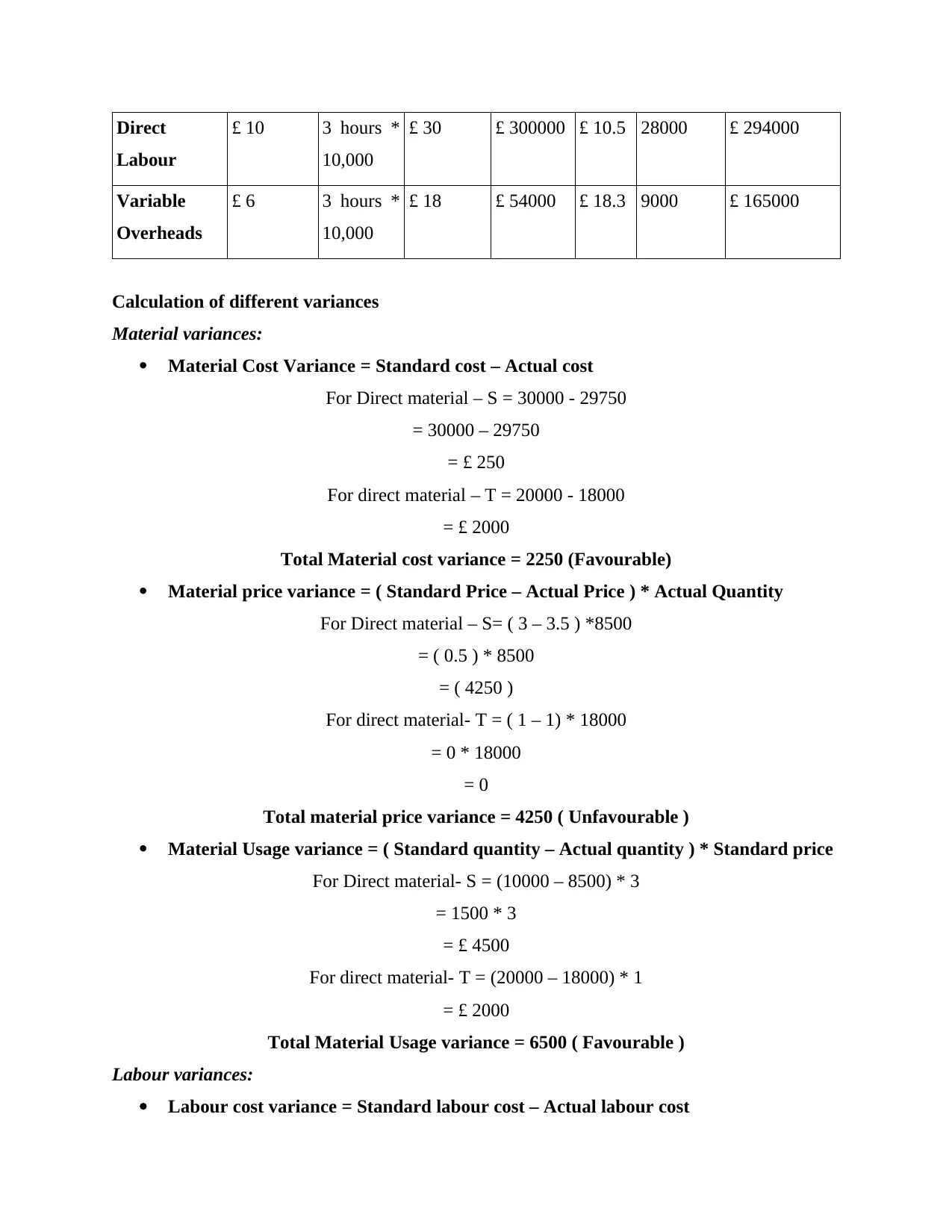
Direct
Labour
£ 10 3 hours *
10,000
£ 30 £ 300000 £ 10.5 28000 £ 294000
Variable
Overheads
£ 6 3 hours *
10,000
£ 18 £ 54000 £ 18.3 9000 £ 165000
Calculation of different variances
Material variances:
Material Cost Variance = Standard cost – Actual cost
For Direct material – S = 30000 - 29750
= 30000 – 29750
= £ 250
For direct material – T = 20000 - 18000
= £ 2000
Total Material cost variance = 2250 (Favourable)
Material price variance = ( Standard Price – Actual Price ) * Actual Quantity
For Direct material – S= ( 3 – 3.5 ) *8500
= ( 0.5 ) * 8500
= ( 4250 )
For direct material- T = ( 1 – 1) * 18000
= 0 * 18000
= 0
Total material price variance = 4250 ( Unfavourable )
Material Usage variance = ( Standard quantity – Actual quantity ) * Standard price
For Direct material- S = (10000 – 8500) * 3
= 1500 * 3
= £ 4500
For direct material- T = (20000 – 18000) * 1
= £ 2000
Total Material Usage variance = 6500 ( Favourable )
Labour variances:
Labour cost variance = Standard labour cost – Actual labour cost
Labour
£ 10 3 hours *
10,000
£ 30 £ 300000 £ 10.5 28000 £ 294000
Variable
Overheads
£ 6 3 hours *
10,000
£ 18 £ 54000 £ 18.3 9000 £ 165000
Calculation of different variances
Material variances:
Material Cost Variance = Standard cost – Actual cost
For Direct material – S = 30000 - 29750
= 30000 – 29750
= £ 250
For direct material – T = 20000 - 18000
= £ 2000
Total Material cost variance = 2250 (Favourable)
Material price variance = ( Standard Price – Actual Price ) * Actual Quantity
For Direct material – S= ( 3 – 3.5 ) *8500
= ( 0.5 ) * 8500
= ( 4250 )
For direct material- T = ( 1 – 1) * 18000
= 0 * 18000
= 0
Total material price variance = 4250 ( Unfavourable )
Material Usage variance = ( Standard quantity – Actual quantity ) * Standard price
For Direct material- S = (10000 – 8500) * 3
= 1500 * 3
= £ 4500
For direct material- T = (20000 – 18000) * 1
= £ 2000
Total Material Usage variance = 6500 ( Favourable )
Labour variances:
Labour cost variance = Standard labour cost – Actual labour cost
Paraphrase This Document
Need a fresh take? Get an instant paraphrase of this document with our AI Paraphraser

=10 – 10.5
= 0.5
Labour rate variance = ( Standard rate – Actual rate ) * Actual hour
= ( 300000 – 294000 ) * 28000
= 6000 * 28000
=168000000
Labour efficiency variance = ( Standard hours – Actual Hours ) * standard rate
= ( 30000 – 28000 ) * 10
= 2000 * 10
= 20,000
Variable overhead variance = Standard variable overhead – Actual variable overhead
= 180000 – 165000
= 15000
b) From the available information suggest possible explanations for the variances identified.
Cost variances refers to the process of determining the financial performance of a production
project. The management calculates the variances in the basis of actual and budgeted costs of the
projects (Mukonza, and Swarts, 2020). The variances help the business decide how the business
is doing in the specified project. Cost variance is the difference between the actual and the
projected costs. It is critical for the management to ascertain the variance as it reveals the
important information regarding a project or a period. It shows how the company is lacking and
it gives them insight about how much the costs are variant from the projected ones. With this
information in hand the company can take necessary steps to reduce the costs and increase the
profits of the business. The above calculations are now being discussed.
Material variance is the difference between the actual cost incurred of direct materials and the
ones which were projected for the project. This variance determines the ability of the production
unit to incur the costs close to the levels which were planned for the project. The material cost
variance and material usage variance for the first quarter of K plc is favourable but material price
variance is unfavourable for the company. Labour variance determines the efficiency that the
labour is having in the production unit. It compares the cost of labour planned and what have
been incurred actually. The labour price variance of the company is favourable. Variable
= 0.5
Labour rate variance = ( Standard rate – Actual rate ) * Actual hour
= ( 300000 – 294000 ) * 28000
= 6000 * 28000
=168000000
Labour efficiency variance = ( Standard hours – Actual Hours ) * standard rate
= ( 30000 – 28000 ) * 10
= 2000 * 10
= 20,000
Variable overhead variance = Standard variable overhead – Actual variable overhead
= 180000 – 165000
= 15000
b) From the available information suggest possible explanations for the variances identified.
Cost variances refers to the process of determining the financial performance of a production
project. The management calculates the variances in the basis of actual and budgeted costs of the
projects (Mukonza, and Swarts, 2020). The variances help the business decide how the business
is doing in the specified project. Cost variance is the difference between the actual and the
projected costs. It is critical for the management to ascertain the variance as it reveals the
important information regarding a project or a period. It shows how the company is lacking and
it gives them insight about how much the costs are variant from the projected ones. With this
information in hand the company can take necessary steps to reduce the costs and increase the
profits of the business. The above calculations are now being discussed.
Material variance is the difference between the actual cost incurred of direct materials and the
ones which were projected for the project. This variance determines the ability of the production
unit to incur the costs close to the levels which were planned for the project. The material cost
variance and material usage variance for the first quarter of K plc is favourable but material price
variance is unfavourable for the company. Labour variance determines the efficiency that the
labour is having in the production unit. It compares the cost of labour planned and what have
been incurred actually. The labour price variance of the company is favourable. Variable
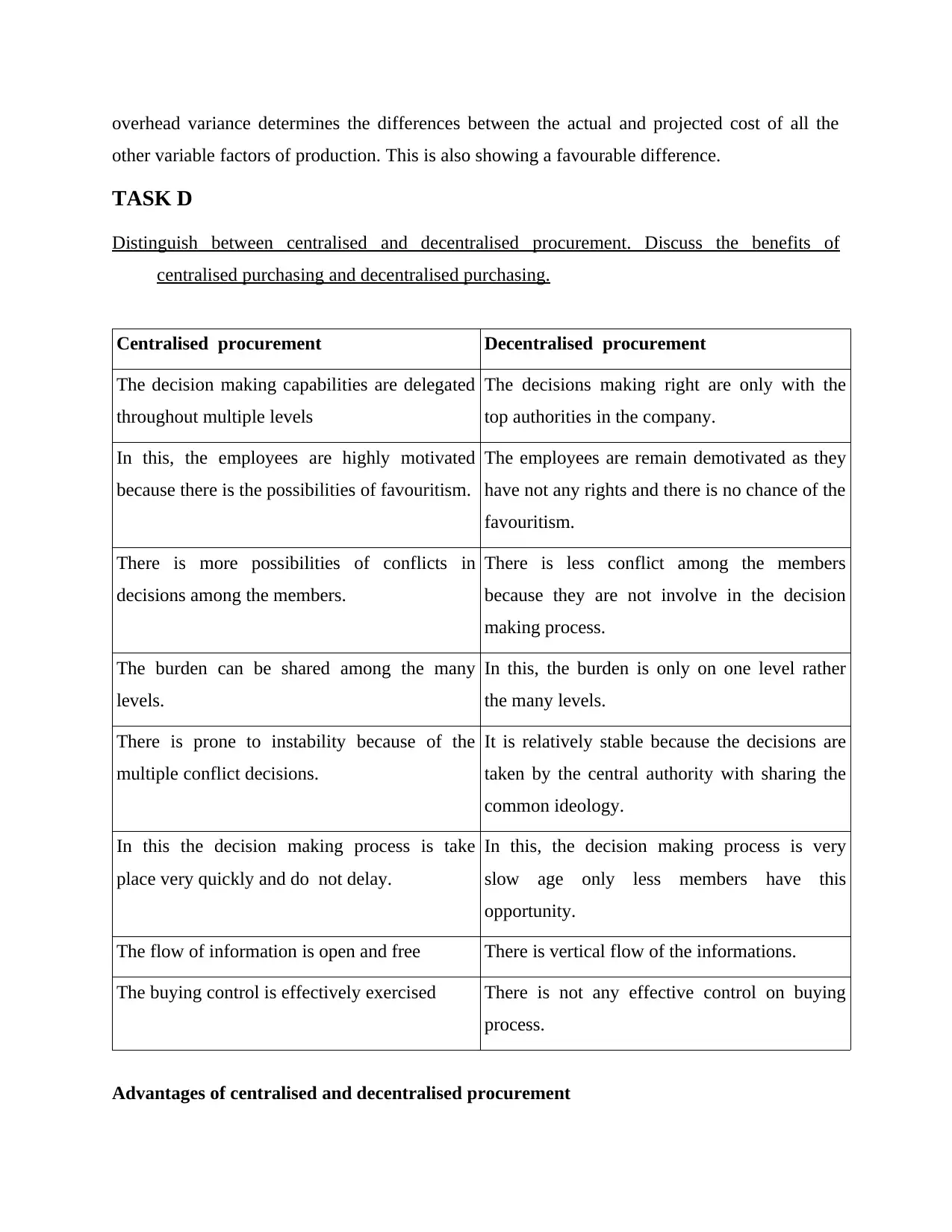
overhead variance determines the differences between the actual and projected cost of all the
other variable factors of production. This is also showing a favourable difference.
TASK D
Distinguish between centralised and decentralised procurement. Discuss the benefits of
centralised purchasing and decentralised purchasing.
Centralised procurement Decentralised procurement
The decision making capabilities are delegated
throughout multiple levels
The decisions making right are only with the
top authorities in the company.
In this, the employees are highly motivated
because there is the possibilities of favouritism.
The employees are remain demotivated as they
have not any rights and there is no chance of the
favouritism.
There is more possibilities of conflicts in
decisions among the members.
There is less conflict among the members
because they are not involve in the decision
making process.
The burden can be shared among the many
levels.
In this, the burden is only on one level rather
the many levels.
There is prone to instability because of the
multiple conflict decisions.
It is relatively stable because the decisions are
taken by the central authority with sharing the
common ideology.
In this the decision making process is take
place very quickly and do not delay.
In this, the decision making process is very
slow age only less members have this
opportunity.
The flow of information is open and free There is vertical flow of the informations.
The buying control is effectively exercised There is not any effective control on buying
process.
Advantages of centralised and decentralised procurement
other variable factors of production. This is also showing a favourable difference.
TASK D
Distinguish between centralised and decentralised procurement. Discuss the benefits of
centralised purchasing and decentralised purchasing.
Centralised procurement Decentralised procurement
The decision making capabilities are delegated
throughout multiple levels
The decisions making right are only with the
top authorities in the company.
In this, the employees are highly motivated
because there is the possibilities of favouritism.
The employees are remain demotivated as they
have not any rights and there is no chance of the
favouritism.
There is more possibilities of conflicts in
decisions among the members.
There is less conflict among the members
because they are not involve in the decision
making process.
The burden can be shared among the many
levels.
In this, the burden is only on one level rather
the many levels.
There is prone to instability because of the
multiple conflict decisions.
It is relatively stable because the decisions are
taken by the central authority with sharing the
common ideology.
In this the decision making process is take
place very quickly and do not delay.
In this, the decision making process is very
slow age only less members have this
opportunity.
The flow of information is open and free There is vertical flow of the informations.
The buying control is effectively exercised There is not any effective control on buying
process.
Advantages of centralised and decentralised procurement
⊘ This is a preview!⊘
Do you want full access?
Subscribe today to unlock all pages.

Trusted by 1+ million students worldwide
1 out of 15